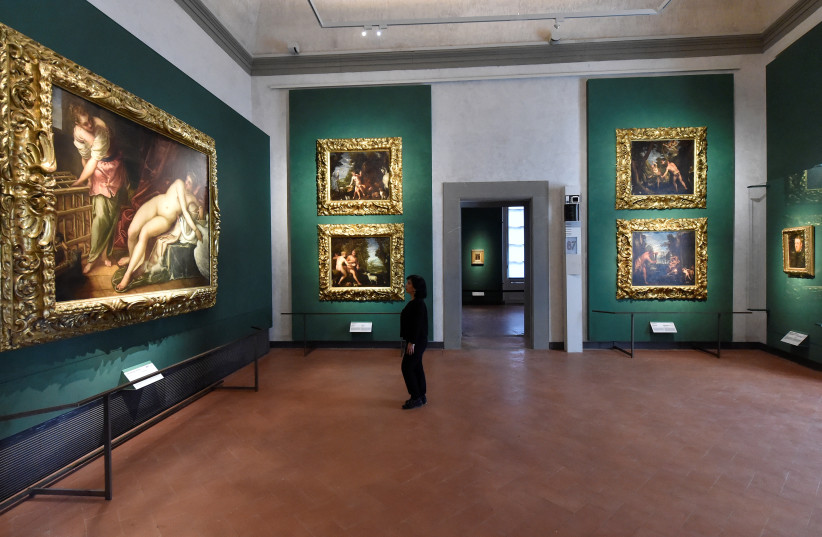“A novel in two parts” is how Michelene Wandor subtitles her new book Orfeo’s Last Act, and her description is strictly accurate. Half the plot, set in Renaissance Italy, is concerned with how Monteverdi’s four-act opera Orfeo gained not one, but two fifth acts, one of which – composed by the Jewish musician Salamone Rossi – was performed only once, and whose manuscript was hidden in an English manor house to lie undiscovered for centuries. The other half of the plot, set in modern-day England, tells how that lost musical manuscript was discovered by Prof. Emilia Constantine, and what followed.
The novel is presented to the reader in truly innovative fashion. The two parts of the story run side by side down the 262 pages of the book, part one on the evenly numbered pages; part two on the odd.
The story of how Salamone’s early musical talent was discovered and fostered, and of his subsequent career largely in the court of the Duke Vincenze, appears on tinted paper on the left. The account of how Prof. Constantine found herself on a sabbatical, committed to research in the area of 17th-century music, and how this led her to the discovery of Salamone’s manuscript – this occupies the right-hand pages.
An innovatively presented novel, spread across two sides of the book
Opening the novel, the reader wonders whether to read the whole of part one and then move on to part two or, since the two parts run in parallel, to follow the plot by reading alternate chapters. Either choice will provide a narrative in which the vibrant role of music is endowed by Wandor with a deep understanding of its nature and emotional appeal.
Wandor is a playwright, poet, short story writer, cultural commentator and musician. Her dramatization of Eugene Sue’s The Wandering Jew was the first drama by a British woman playwright to be staged in Britain’s National Theatre. With her early music group, Siena, she produced the first CD in the UK of the music of Salamone Rossi, Il Mantovano Hebreo.

Both parts of Orfeo’s Last Act, suffused with musical content, are enriched by sub-themes. Part one incorporates well-researched accounts of life for Jews in 17th-century Italy illustrating the wide disparity between life in the ghettos of the larger cities and life at court for the privileged few. The second part seamlessly, and appropriately, integrates the theme of forgery into the account of the finding and the fate of the lost fifth act of Monteverdi’s opera Orfeo. Something else links them – a point so under-emphasized that some readers may not pick it up – and that is the name Emilia. The name of Salamone’s African mistress and mother of his children is echoed in the character of Prof. Constantine, who discovers the long-lost manuscript.
At one point in Salamone’s story, with his stock high at court, his father summons him to a meeting. It is a somber group, writes Wandor, headed by Rabbi David Provenzal.
“Salamone is a clever and talented young man,” says the rabbi. “I am sorry he spends so much time singing in Latin. I am sorry that he lives among the gentiles. I am sorry that he helps to celebrate a non-religion.”
In response, Salamone says he is no different from the other musicians and performers who adorn the duke’s court. And, he adds, “We invite the Duke and his guests to visit our synagogues. What is the problem?”
“One day,” says the rabbi, “you’ll displease the Duke, and the whole community will be punished. Some monk will accuse the Jews of polluting the Catholic church; of killing Catholic babies.”
“Perhaps the palace is the best place to be,” says Salamone. “We hear everything first. I can forewarn the community if there is any danger.”
“When any Jew finds favor in the Duke’s eyes,” his father points out, “the whole community benefits.”
“Oh, yes?” asks the rabbi, “The Duke has a great deal of respect for us. So much respect that we must advertise our honorable Jewness with a yellow badge of dishonor.”
He opens his cloak. Just inside is a small piece of yellow cloth.
Everyone laughs, writes Wandor, and similarly opens their cloaks and jackets.
“‘The Duke has given me a special dispensation,’ says the rabbi, ‘so that I do not need to display the badge in public.’
“‘Then,’ says Salamone, ‘you are the same as I am. I have a special dispensation to move freely about the Palazzo Ducale without wearing my badge. No one has ever challenged me.’
“‘We are fortunate,’ says his father. “‘We are not in Florence. We are not in Venice. We do not live in a ghetto.’
“‘It’s only a matter of time,’ says the rabbi.”
Although Wandor has written a great many books covering a wide variety of subjects that interest her, Orfeo’s Last Act is her first novel. This multi-layered and highly readable narrative is an outstanding piece of work. Readers will await her next in pleasurable anticipation.
- ORFEO’S LAST ACT: A NOVEL IN TWO PARTS
- By Michelene Wandor
- Greenwich Exchange, London
- 264 pages; $18
